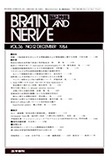Japanese
English
- 有料閲覧
- Abstract 文献概要
- 1ページ目 Look Inside
抄録 33歳男性。26歳発症の若年性パーキンソン病患者で,2年前よりL-dopa治療が開始され,初期には症状改善をみたが,1年前より不随意運動をみるようになった。ECドパール2錠内服1時間後に全身に激しいバリスムス様不随意運動が生じ15分間持続。後50分間はパーキンソン症状が著明に改善した。この時血中ドーパ濃度は上昇しており,onset-of-dose dyskinesiaと考えられた。end-of-dose dyskinesiaはみられなかった。一方,L-dopa500mg内服では1時間後に両上肢の舞踏病様運動が数分間出現したが,パーキンソン症状は改善しなかった。内服3時間20分後再び舞踏病様不随意運動が数分間出現し,これに続いてパーキンソン症状は著しく改善し,さらに30分経ると激しい全身のバリスムス様不随意運動が出現し,30分間持続して消失するとともにパーキンソン症状は急激に悪化した。この時血中ドーパ濃度は下降しており,end—of-dose dyskinesiaと考えられた。本症例はドーパ投与法により主にonset-of-dose dyskinesiaあるいはend-of-dose dyskinesiaを生じた点とドーパの血中濃度変化時にパーキンソン症状の改善を伴わない軽度の不随意運動をみた点で特異であり,また,diphasic dyskinesiaの発現機序について考察した。
A 33-year-old male with diphasic dyskinesia was presented. He began to have difficulty with walk-ing at the age of 27, and was diagnosed to have jevenile parkinsonism. For the past two years, L-dopa has been prescribed with good initial re-sponse. One year ago peripheral dopa decarboxylase inhibitor in combination with L-dopa was started, and he began to have involuntary movements.
One hour after taking 2 tablets of EC dopar (L-dopa 100mg+ benserazide 25mg), violent in-voluntary ballistic movements appeared in all four extremities which lasted for 15minutes. For the following 50minutes, his symptoms of parkinson-ism markedly improved. The score of parkinson-ism reduced by 58%, and he was able to walk. The plasma dopa level was increasing during this period. However, during decreasing period of plasma dopa concentration, he did not have end-of-dose dyskinesia.
On the other hand, one hour after taking 500mg of L-dopa involuntary choreic movements appeared in his right upper extremity for several minutes without any improvement of parkinsonism. Three hours and 20 minutes after taking L-dopa, he developed mild choreic movements for severalminutes followed by marked improvement of parkinsonism for 30 minutes. The score of parkin-sonism reduced by 79%. Thirty minutes later, he developed violent ballistic movements in all four extremities, lasting for 30 minutes followed by reappearance of parkinsonism. The concentration of plasma dopa was decreasing during this period.
Characteristics of diphasic dykinesia of this patients include the facts that he showed either violent ballistic onset- or end-of-dose dyskinesia followed by improvement in parkinsonism or de-terioration of improvement of symptoms, respec-tively and that mild involuntary movements with-out changes in parkinsonism were present while plasma dopa concentration was changing.
One hour after administration of bromocriptine 7.5mg and 10mg he also showed violent tremor-ous or ballistic movements in his both upper extremities for from 10minutes to one hour with improvement in parkinsonism. Those were thought to be onset-of-dose dyskinesia.
Previously proposed hypotheses regarding to mechanism of diphasic dyskinesia include postsynap-tic depolarization blockade of dopaminergic neurons and unbalance of activities of two types of dopamine receptors (D1 and D2).
We postulated that alterations in the functional state of the dopamine receptor at the nucleus ac-cumbens should also be considered as a possible mechanisms of diphasic dyskinesia. In addition, a transient malfunction of the pallido-luysian system may also be playing a role because of the ballistic nature of diphasic dyskinesia.

Copyright © 1984, Igaku-Shoin Ltd. All rights reserved.


